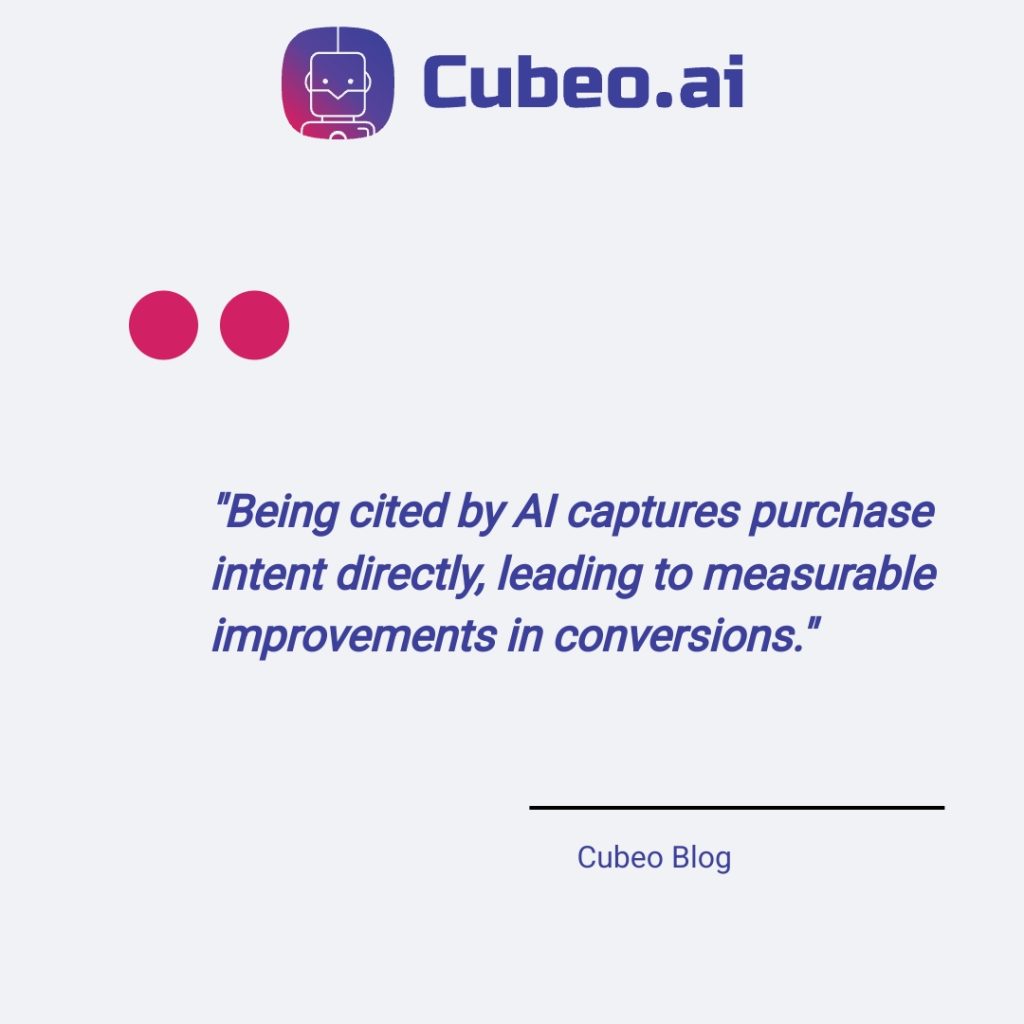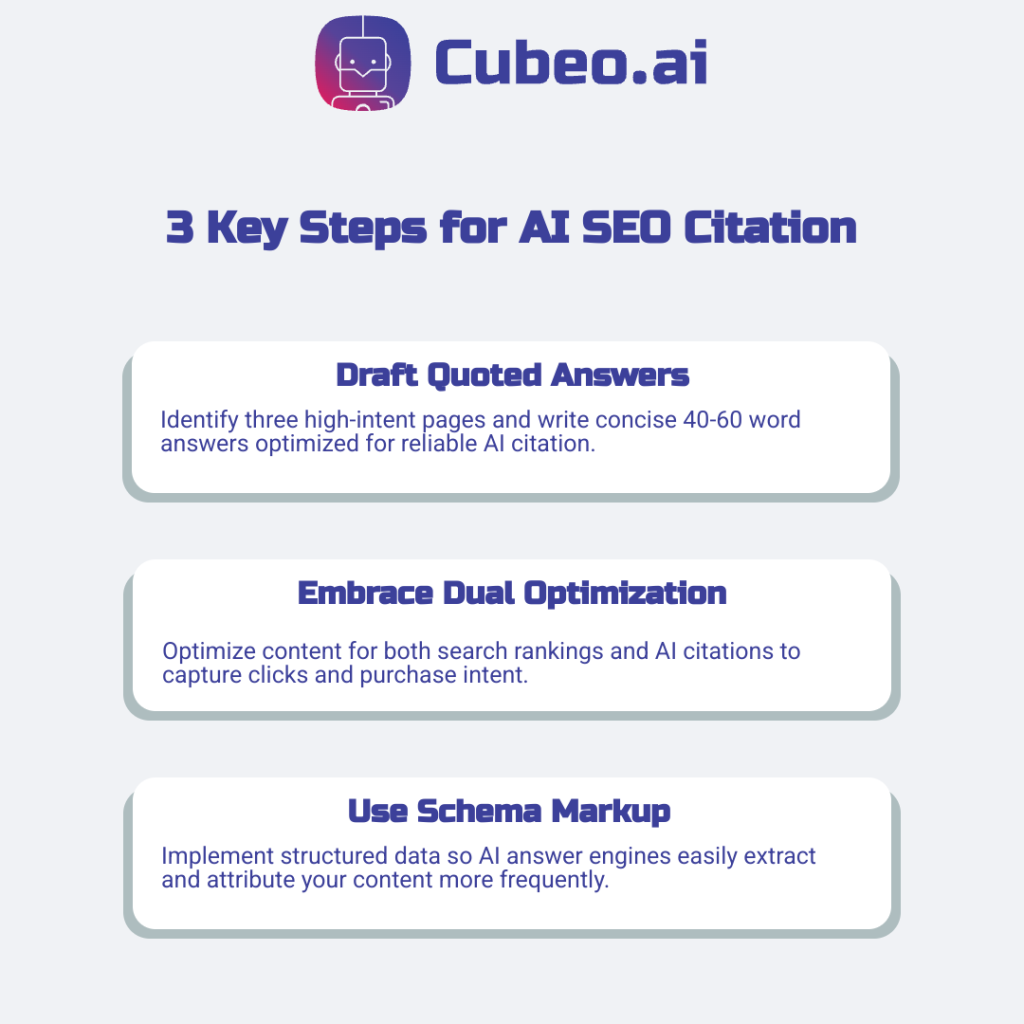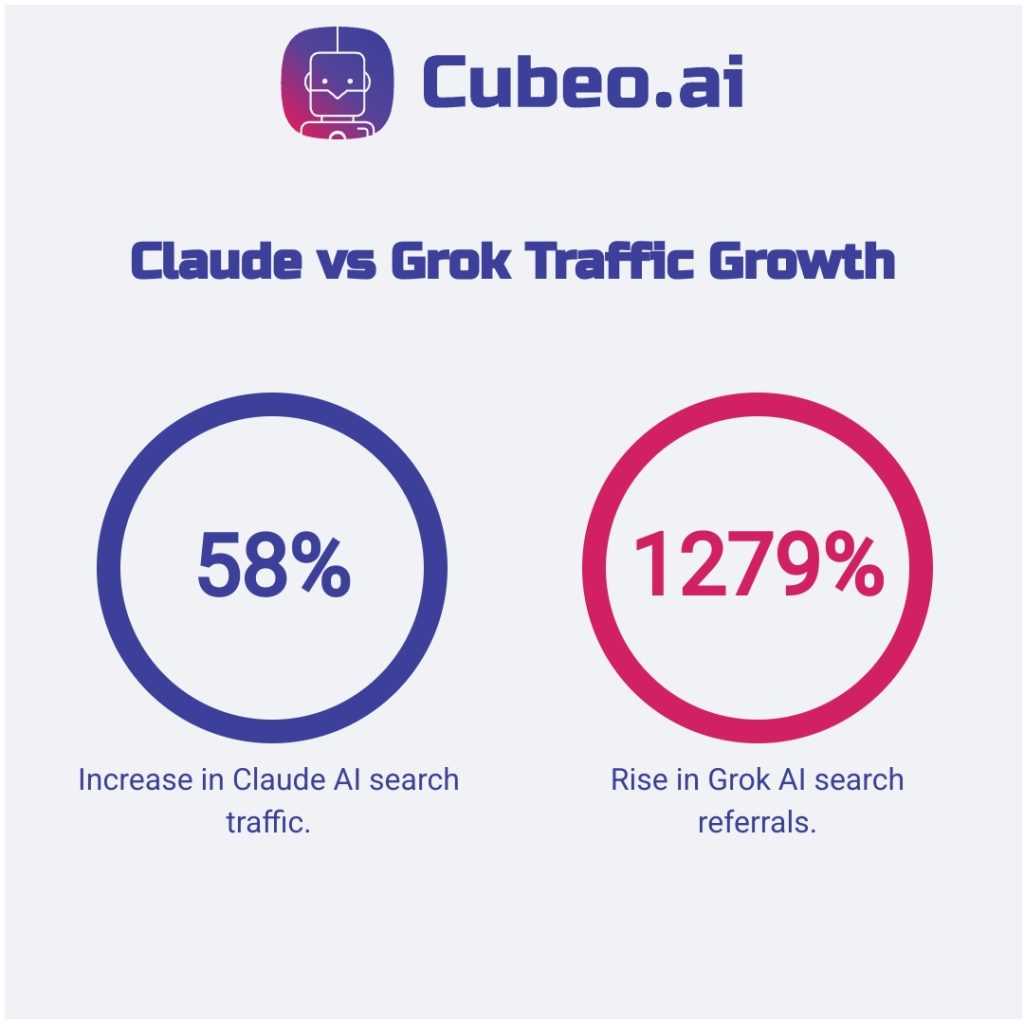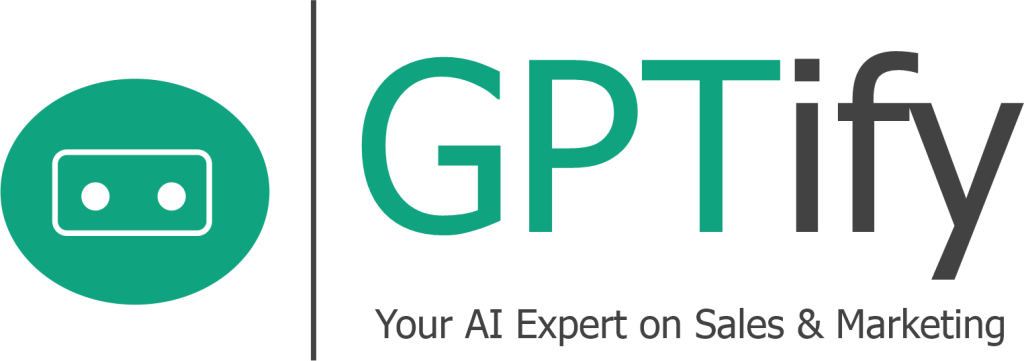• Capture purchase intent directly: Being quoted by ChatGPT or Perplexity when users ask buying questions converts better than traditional search rankings because the AI recommendation feels like expert curation rather than advertising
• Master the 40-60 word quoted answer format: This specific structure gets your content cited by AI engines – one company achieved a 349.5% increase in keywords appearing in Google AI Overview using this approach
• Measure what matters for AI visibility: Track citation frequency and source attribution rates instead of just search rankings, as 65% of Google searches now end without clicks and 25% of organic traffic is moving to AI chatbots by 2026
• Automate the optimization process: Teams using agentic AI workflows report 50% reduction in project time, compressing weeks of manual AEO work into days while maintaining quality control
• Implement dual optimization strategy: You need both traditional SEO (to get indexed) and AEO (to get quoted) – the citation economy rewards different content signals than the ranking economy
The playbook ahead shows you exactly how to build this competitive advantage before your competitors catch on.
Answer Engine Optimization: The Practitioner's Playbook for Getting Quoted by AI
Your content ranks on page one. But when someone asks ChatGPT or Perplexity about your topic, does your content get quoted in the answer?
Traditional SEO gets you ranked in search results. Answer engine optimization (AEO) gets you quoted by AI answer engines like ChatGPT, Perplexity, and Claude. Teams implementing AEO report measurable improvements in conversions because being cited captures purchase intent directly.
Your four-step playbook: define a 40-60 word quoted answer pattern, structure content for machine retrieval, measure citation performance, and automate the optimization loop.
Quoted Answer Pattern Example (52 words): “For remote teams choosing project management software, prioritize asynchronous communication features, third-party integrations, and lightweight task tracking. Recommended: Tool X offers video notes, API connections, and offline sync. This combination supports distributed teams needing quick onboarding and reliable collaboration without overwhelming complexity.”
This pattern works because it directly answers user questions in the format AI tools prefer to quote.

What Answer Engine Optimization Means for AI SEO
The economics of search have shifted. While traditional SEO chases click-through rates, answer engine optimization (AEO) targets something more valuable: being the source AI tools quote when users ask questions.
First action: Pick 3 high-intent pages and draft a 40-60 word quoted answer for each this week.
AEO optimizes content specifically for AI-powered answer engines like ChatGPT, Perplexity, Claude, and Google’s AI Overviews. ChatGPT hit 5.14 billion visits in April 2025 and Best Western achieved a 349.5% increase in keywords appearing in Google AI Overview through strategic content restructuring. Meanwhile, 65% of Google searches end without clicks and Gartner forecasts 25% of organic traffic moving to AI chatbots by 2026.
This creates a dual-optimization approach where LEO (Large Language Model Optimization) works alongside traditional SEO. You need both: SEO gets you indexed, AEO gets you quoted.
The Citation Economy vs Ranking Economy
Traditional SEO optimizes for SERP position and click-through rates. AEO optimizes for citation and attribution within AI-generated answers.
The shift is measurable and urgent. Users increasingly trust AI-recommended sources over traditional ads because the recommendation feels like expert curation rather than paid placement.
Citations provide direct authority. When ChatGPT quotes your content in response to “What’s the best CRM for small businesses?” you capture purchase intent without competing for clicks. The citation becomes your brand’s endorsement by the AI tool itself.
Why Answer Engines Choose Certain Sources
Answer engines prefer short, well-labeled answers. In practice: tight headings, a one-paragraph 40-60 word answer, and a clear source citation make your content easy for models to quote.
Schema markup helps AI models understand content context. A product page with proper structured data (which means organized information that machines can read) gets quoted more often than one without markup, even if both rank similarly in traditional search.
You should treat each high-value page as a candidate to convert into a quoted asset. The key: content that directly addresses user questions in segments that AI models can confidently extract and cite with attribution back to your brand.

How AI Answer Engines Pick Sources to Quote
Action: Add FAQPage schema and place a 40-60 word quoted answer under one high-value heading this week, validate with Google’s Rich Results Test.
AI models follow predictable patterns when selecting sources to cite. Analysis of 8,000 AI citations reveals Wikipedia captures 27% of ChatGPT citations, while blogs account for 38% and news sources 23% across major AI engines.
LLMs look for three practical signals you can control:
- Phrase match: Use the user’s question wording in your heading and opening sentence
- Machine-readable structure: Add FAQPage/Speakable JSON-LD so your answer is extractable
- Authority cues: Include author metadata, primary-source links, and an inbound citation from a trusted domain.
AI search traffic remains under 1% of total referrals but shows rapid growth, with Claude up 58% and Grok up 1,279% in recent months.
Real-Time Data Enrichment with RAG
RAG systems (Retrieval-Augmented Generation) keep quoted information current by pulling live data when AI models generate responses. RAG implementation in 3 steps:
1. Identify live fields to surface (price, inventory, ETA)
2. Expose canonical JSON via secure API or CMS webhook
3. Refresh RAG index on schedule (every 60 minutes for pricing) and log mismatches
Validation test: Run sample queries that pull live fields into generated answers and compare values; alert if mismatches exceed 0.5%.
Recent AI advancements enable real-time data integration across dynamic topics. Expect 10-25% increase in LLM mentions over 8 weeks after implementation.
Content Structure for LLM Processing
Use H2-H4 tags that mirror user questions. Put a 40-60 word answer directly under each question heading so models can extract quotable blocks without parsing long paragraphs.

Measuring AEO Success with the Right KPIs
Most teams track traditional SEO metrics while missing the signals that matter for AI citation. The measurement gap costs visibility and revenue.
First action: Add 3 high-value pages to a citation-monitoring set, capture baseline counts this week, and tag the target queries that should quote each page.
AI Overviews now appear in 18% of global searches, with organic clicks dropping 34.5% when AI summaries appear without proper AEO optimization. You can measure impact by tracking citation lift over 4-8 weeks. Early AEO adopters see 65% higher brand mention rates, and cross-platform optimization can increase visibility by 280%.
Core AEO Metrics to Track
Track these four measurable KPIs:
- Citation frequency — Monthly count of distinct AI answers that quote or link to your page (tracked via fixed query set)
- Source attribution rate — % = (AI answers that include a link to your domain ÷ total AI answers referencing the topic) × 100
- Query coverage — % of tracked target questions that return an AI answer quoting your content
- Answer engine visibility score — (# times quoted across tracked engines ÷ # tracked queries) × 100
Monitor weekly for trending topics, monthly for evergreen content.
Baseline Thresholds and Targets
Directional targets vary by industry, but aim for:
- 15-25% snippet share in your pilot vertical within 6 months
- 5+ monthly citations per high-value page across major AI platforms
- 80% speakable coverage of key landing pages (% with Speakable/FAQ schema + 40-60 word answer present)
Run pilot tests first. B2B software typically sees higher citation rates than consumer retail. Adjust expectations based on content volume and competitive landscape.
Conclusion
Manual AEO optimization consumes weeks of research, analysis, and implementation time. Agentic workflows (multiple AI agents coordinating tasks) compress this timeline into days while maintaining quality control.
The efficiency gains are measurable. Teams report over 50% reduction in project time and effort through agentic AI automation (Jam7 pilot study).
Google’s AI Overviews now intercept 30-45% of clicks from traditional organic results (ZenMedia analysis).
The key is human-in-the-loop validation where people review and approve AI work before it goes live. This maintains strategic control while capturing automation benefits.
FAQ
How long does it take to see results from Answer Engine Optimization?
Seeing results from Answer Engine Optimization (AEO) typically takes weeks to months, with established sites potentially observing early wins within a few weeks, while newer sites might require 12-18 months. The timeline is influenced by factors such as your website’s current state, existing SEO foundation, resources, and the competitiveness of your target queries.
For instance, a well-optimized FAQ page with schema markup could appear in Google’s “People Also Ask” section within 4-6 weeks. However, for more significant results, a timeframe of 3-6 months is often more realistic. AEO optimizations can sometimes deliver results faster than traditional SEO, with some brands seeing measurable AI visibility improvements within 6-8 weeks of sustained effort, as AI engines can integrate new information more rapidly.
It’s important to set modest goals, such as earning 1-2 mentions for a related set of questions, and track accessible metrics like citations, mentions, and referral traffic. A quarterly timeline can provide initial insights into referral traffic from answer engines and help bolster support for ongoing AEO efforts.
Can AEO work alongside traditional SEO strategies?
Absolutely, Answer Engine Optimization (AEO) and traditional SEO strategies are not mutually exclusive; they are complementary and work best when integrated. While traditional SEO focuses on improving website rankings and driving organic traffic through keywords, backlinks, and technical site health, AEO specifically targets AI-powered answer engines to deliver direct, concise answers.
Think of it as upgrading your operating system rather than buying a new computer. Your traditional SEO efforts build the foundational authority and technical robustness of your site, which AI-powered search engines often rely on to determine trustworthy sources. AEO then ensures your content is perfectly structured and presented for seamless AI consumption, crafting content that not only ranks well in traditional search results but also provides direct, quotable answers that AI craves. This hybrid approach can lead to increased search visibility, with some data suggesting websites using both AEO and SEO strategies gain significantly more visibility than those relying solely on traditional SEO.
How do I measure ROI from answer engine citations?
Measuring the Return on Investment (ROI) from answer engine citations involves tracking the incremental conversions and revenue generated directly from AI-generated answers, then comparing these gains against your initial investment in Answer Engine Optimization (AEO). This requires a robust analytics setup, starting with clean UTMs, ad platform data, web/app analytics, and CRM data to correlate AI visibility with actual business outcomes.
Key metrics to focus on include incremental citations, incremental sessions from AI answers, conversion rates (CR), and average order value (AOV). For example, you can calculate incremental revenue by multiplying incremental conversions by your average order value. Beyond direct revenue, consider the broader impact on brand awareness and trust, as appearing in AI answers can boost homepage and branded search activity. While AEO is a long-term strategy, setting modest, measurable goals and tracking these metrics over time will provide valuable insights into the effectiveness of your AEO efforts and help you refine your strategy for continuous improvement.



